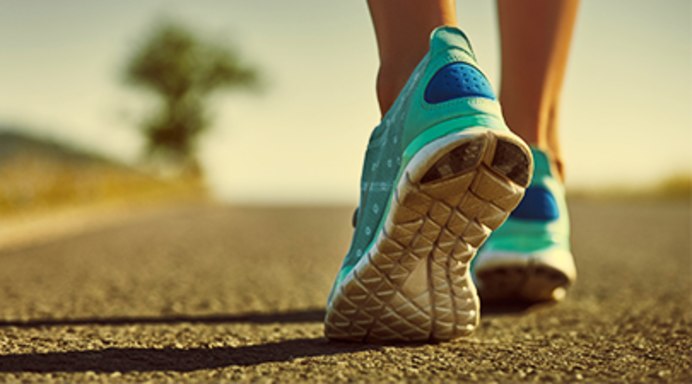
What’s great about walking is that most everyone can do it. You don’t need special equipment, skills or a designated space to walk and you can do it whether you’re in excellent or declining health.
Although you could literally just step outside and walk, it is recommended that you wear a good pair of walking shoes with appropriate arch support if you’re going to be walking regularly.
Walking with improper footwear can actually cause more harm than good including conditions such as shin splints, cramps and even plantar fasciitis (intense heel pain). If you live in a crowded city or in a harsh climate, a treadmill may be a good investment.
Before buying equipment, consider trying one out at a local gym or at a friend’s house. Walking on a machine is not for everyone so do put one to the test before you spend money on one.
Warm up and cool down
If you’re doing more than a leisurely stroll, consider stretching before and after you get moving. Stretching before you walk can help prevent injury, improve performance and reduce muscle pain after the fact.
Cooling down and stretching after physical activity is also important to repair muscle and bring your heart rate down progressively.
Types of stretches do do before and after walking
HAMSTRING AND ANKLE
Sit on the edge of a chair with your right leg extended, right heel on floor. Flex right foot and keep toes pointed up. Lean forward gently from your hips to feel a stretch in the back of your thigh. Repeat with left leg.
CALF STRETCH
Stand up straight, holding on to a chair. Put left leg behind you, keeping left heel on the floor. Bend right knee and lean toward the chair. You should feel the stretch in the calf of the left leg. Repeat with right leg.
GROIN STRETCH
Stand with legs slightly wider than shoulder width and hold on to a chair. With left foot facing forward, point right foot to right 45 degrees then lunge in that direction without letting knee go past toes. Repeat move on left side.
LEG SWINGS
Stand up straight, holding on to a chair with your left hand for support. Standing to the side of the chair on your left leg, move your right leg to the front, side and back, tapping your toe at each point. Repeat with left leg.
The social and psychological benefits of walking
Have you ever walked a dog? Seeing their joy and amazement at everything they see, and smell is enough to get you hooked on walking. Similarly, walking with a human friend may be exactly what you need to get your mind off of problems and worries.
Many mental health professionals will actually encourage their patients to walk with them during a therapy session. Why you might ask? The reason is simple. Walking activates critical hormones in the brain that stimulate clearer thinking and problem solving.
Walking for weight management and toning muscles
Contrary to some misconceptions, you don’t have to suffer to lose weight. Many believe that the saying “No pain, no gain” is the only truth, but that is in fact not the case.
Walking, which is relatively painless to most, may be enough to control your weight, firm and tone your muscles and even lose several pounds.
The key is not to walk long distances but rather to adopt a regular walking habit. A brisk 30 to 45 minutes walk five to six times a week will be sufficient for most.
Set objectives
Setting objectives will force you to focus and strive to achieve them. Make your goals realistic and push yourself to attain them over time. For example, if your usual distance is 2 miles a day, try to reduce the time it takes you to complete your course.
Or if you’re already walking at a fast pace, gradually increase your distance to 2.5 miles. Aim to go from walking on a flat route to one with more hills or change the terrain from asphalt to trail walking.
Tips to ensure a fun walk
Dress in layers and preferably in clothes made from breathable fabric.
Even if the temperature is cool, walking will cause your internal engine to warm you considerably. If you’re overdressed, you may feel too hot midway through your route.
Bring a water bottle.
It may seem unnecessary, but water will significantly cool you down if you become too heated. Don’t drink excessively or you may feel bloated and uncomfortable during your stride.
Switch up the scenery
Walking in your neighborhood is probably the easiest, fastest and most cost-effective route you could take, but sometimes, driving to and walking in a different community will keep you motivated. You’ll see new houses, scenery and people.
Listen to music or podcasts while you walk
Bring a listening device and learn while you walk! There are literally hundreds of thousands of podcasts you can find for free online.
Plug in your ear phones and be inspired. Upbeat music is also a good motivator. You might find yourself walking to the beat with an extra bop in your step.
Walking may be the best activity for overall wellness.
By setting their own pace and distance, people of all ages and abilities can adopt a walking routine that suits them. But did you know that the health benefits of walking go beyond physical health?
Walking may actually re-wire your brain to think more positively, feel more energetic and confident. Walking has been proven to improve depression, memory, posture, insomnia, metabolism and many other conditions.
